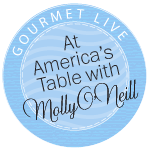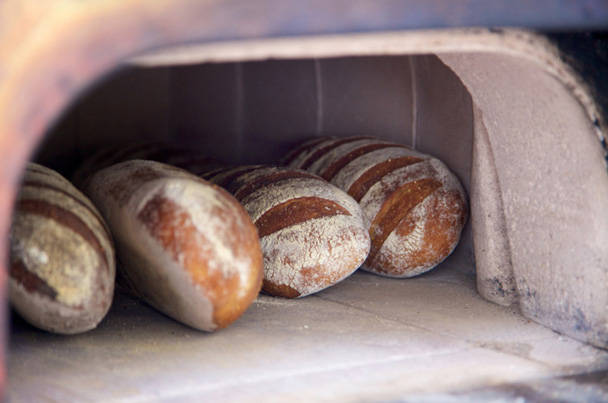
It was just past 8 a.m. and Albie Barden’s well-pressed denim shirt was dotted with dark, indigo patches of sweat. It was nearly 90 degrees; nevertheless, Barden, an Episcopal minister and the founder of the Maine Wood Heat Company (a wood-burning stove and oven company) couldn’t stop himself. On the first morning of the fifth annual kneading conference in Skowhegan, Maine, he inched closer and closer to the blazing mouth of his newest mobile oven.
Perched on a heavy-gauge steel trailer and covered with seamed copper, the oven resembled the back end of a vintage Airstream. It had just been unveiled, and as he discussed his company’s latest design, Mr. Barden’s face was barn red, his white hair was damp, and his blue eyes glowed like those of a True Believer. “We needed aerodynamic,” he said. “We’re going to haul this oven to schools all over the state using it to teach kids about local food.”
The Kneading Conference is a midsummer summit of some of the nation’s most noteworthy philosophers and practitioners of the locavore creed. For three days every July, they gather at the fairgrounds in the former mill town one and a half hour’s drive inland from Portland, Maine, to build wood-fired brick and clay ovens; teach the science of flour, yeast, and fire; and debate strategies for what the conference program describes as “decommodifying grain” and “creating local grain economies.”
Through it all, they never stop baking the sort of crusty rustic bread that turns polite people into carb-crazed maniacs. “The Kneading Conference is the Burning Man of the breadheads,” tweeted Andrew Janjigian (aka @dikaryon) from the conference. But aside from its small encampment of tents, the creative charge in the air, the waiflike and well-inked young idealists, and the high percentage of men-of-a-certain-age wearing ponytails, the Kneading Conference has little in common with the stoned-out artist happening. It’s more like a tent revival. Instead of “seeing the light,” the attendees “tasted the bread.” Delivered from presliced, doughy white, they believe that making better bread makes a better world.
In his search for the perfect loaf, for instance, Pat Manley, a 59-year-old stonemason, learned how to build exquisite, wood-fired brick ovens. Along with his wife, he founded “Masons on a Mission,” a humanitarian relief organization and project of the National Heritage Foundation that replaces the dangerous unvented primitive wood heating stoves found in the homes of impoverished Mayans in Guatemala with vented, energy-efficient brick ones.
“It saves lives, and reduces illness and pollution and costs,” said Mr. Manley as he heaved concrete blocks and fire bricks at the Kneading Conference, where he was demonstrating one of the fancier ovens he also builds. A legend among artisanal bread bakers, Mr. Manley spends his summers creating these state-of-the-art ovens for bakeries and restaurants, including Loaf in Durham, North Carolina; Spread Bagelry in Philadelphia; Matchbox in Washington, D.C.; Fore Street in Portland, Maine; and Fitzpatrick Winery in Fair Play, California; as well as for celebrities such as Billy Joel. In the winter he assembles a team and goes to Guatemala to construct cheap, safe ovens. “They cost $150 in materials, the labor is us—and we don’t cost them a thing,” he told his oven-building students. “So far we’ve built 3,000 of them.”
Stu Silverstein, a frequent volunteer with the Guatemalan stove relief effort, calls it “missionary work.” An artist, documentary filmmaker, and bread baker, Mr. Silverstein blogs about his search for fabulous bread at www.Ibreadhunter.blogspot.com and is the author of Bread Earth and Fire, a book that describes breads from around the world; he also builds and bakes in outdoor wood-fired ovens. He was standing near Mr. Manley at the conference, making adobe beehive ovens with a group of wood-fire-baking acolytes. “People have a primal response to live fire,” said the 72-year-old. “It’s powerful, an irresistible pull. Giving people warmth and the ability to cook saves lives.”
Adding the smoky, yeasty scent of baking bread compounds this primal allure, said Jonathan Rubenstein, who attends the conference every year. Along with his wife, Linda Motzkin, Mr. Rubenstein is a co-rabbi at Temple Sinai in Saratoga Springs, New York. Five years ago, Mr. Rubenstein began baking challah, the traditional bread of Friday evening’s Shabbat meal, in the Temple’s tiny kitchen.
“The smell alone pulled in people who’d never attended services,” he said. In addition to his challah baking, he created Slice of Heaven, a nonprofit volunteer bakery that teaches at-risk children the principles of fine bread making. Along with dozens of volunteers from his congregation, the children produce loaves that are sold to benefit local hunger relief; unsold loaves are given to the local food bank.
Historically, said the rabbi, communal ovens were the hub of small-town community. People would make their dough at home, create the loaves, slice an identifying insignia into the top, and carry them to the town oven to bake. “We’re seeing a renaissance of little communities taking shape around ovens,” said Mr. Rubenstein. Americans, he said, are hungry for something real, something to share, something to return to on a regular basis, he said, and he added, “My wife and I started leading retreats called “Bread and Torah.”
Venerable food activists such as Dusty Dowse say that the power of bread and fire is part of the reason that artisanal bread and local grains are rapidly replacing heirloom tomatoes as the stars in the taste epiphanies of recent converts to locavorism. But perhaps the tenets of the creed have also expanded, becoming less about individual epicurean experience and more a latter-day Salvation Army, bent on saving the American landscape, small family farms, and local economies.
Three decades of living organically, locally, and sustainably has, after all, taught church elders the limits of individual experience and pushed them past backyard gardens and seasonal farmers’ markets to more complicated crops, like cattle and grain.
“I love a great tomato,” said Dr. Dowse, “but you can’t live on tomatoes and you can live on bread. Bread is central to our being. You plant it and you have to stay in one place, to mill it and store it and bake it, and that requires community and cooperation. Bread is the basis of civilization.”
A cardiac cell biologist at the University of Maine who has been baking rustic bread for nearly 40 years, Dr. Dowse was an early supporter of the Kneading Conference. He also wrote the grant for the copper-domed oven that Mr. Barden built. A self-described “old hippie,” Dowse worked as a truck stop cook and raised sheep before joining the faculty at the university. He sees the bread oven as an agent for social change. He calls the copper-topped model “an outreach oven.” He refers to the Kneading Conference and Artisanal Bread Fair as “an outreach event.”
Skowhegan, he says, is an example of a world that bread can save.
In the 1830s, the town produced enough grain to feed 100,000 people. As manufacturing mills moved in, grain production dipped. By the mid-1950s, when the railroad left and the town’s shoe and clothing manufacturers moved abroad, Skowhegan wasn’t raising enough grain to feed the 8,000 who continued to live there.
Locavorism, meet local economic crisis.
Along with other amateur bakers, Dr. Dowse began to study the more nutritious and better-tasting antique varieties of grains that never appear in the commodity markets. Soon, the Universities of Vermont and Maine began collaborating on a study to identify the grains best suited for growing conditions north of the 45th parallel. Dr. Dowse persuaded Mr. Barden to expand his heating business to include wood-fired cooking ovens. as well. Initially, the Kneading Conference showcased the ovens and created a forum for people to learn about grain growing and baking. And it worked its magic. Smitten by the emerging bread culture, Amber Lambke, a former speech language pathologist and Michael Scholz, a baker, set their sights on creating a local gristmill as an incentive to encourage wider-scale grain farming in the area. When the local Somerset jail was abandoned, they raised money from private investors and public grants to buy it. Six growers planted nearly 600 acres of grain to supply the mill. The Austrian-built, 5,800-pound beauty will begin crushing fine flour for their Somerset Grist Mill label in October.
“The mill could help create four jobs, help support about a dozen farms and a dozen additional food businesses, and add slightly more than a million dollars to the local economy,” said Ms. Lambke. Leaning close to the glowing mouth of Mr. Barden’s new oven, she closed her eyes, inhaled, and added, “That means we will be supplying the flour to make about 1,000,200 loaves of bread a year.”
Molly O’Neill is the author of seven books including Mostly True: A Memoir of Family, Food, and Baseball, The New York Cookbook, and One Big Table: A Portrait of American Cooking. Her e-book, This American Burger, the first in a series that documents individual dishes and the people who prepare them, was just published by New Word City.

